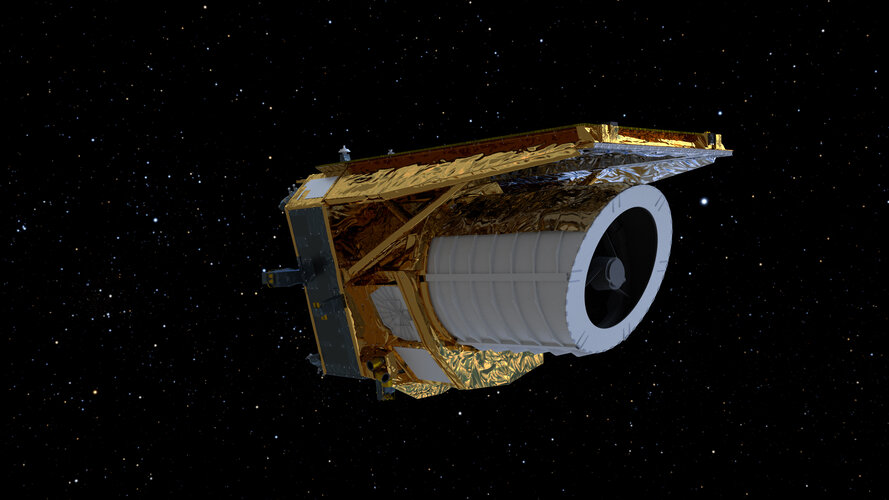
Copernical Team
Wednesday, 12 July 2023 02:16
High-Velocity Impacts Explored in Experimental Study
Los Angeles CA (SPX) Jul 12, 2023
 Scientists from Johns Hopkins University have conducted a groundbreaking experimental study to unravel the mysteries behind impact flashes generated by high-velocity impacts. With debris and meteoroids posing a significant threat to satellites, space probes, and hypersonic craft, understanding the nature and characteristics of these impact flashes is crucial for ensuring the safety and durabilit
Scientists from Johns Hopkins University have conducted a groundbreaking experimental study to unravel the mysteries behind impact flashes generated by high-velocity impacts. With debris and meteoroids posing a significant threat to satellites, space probes, and hypersonic craft, understanding the nature and characteristics of these impact flashes is crucial for ensuring the safety and durabilit
 Scientists from Johns Hopkins University have conducted a groundbreaking experimental study to unravel the mysteries behind impact flashes generated by high-velocity impacts. With debris and meteoroids posing a significant threat to satellites, space probes, and hypersonic craft, understanding the nature and characteristics of these impact flashes is crucial for ensuring the safety and durabilit
Scientists from Johns Hopkins University have conducted a groundbreaking experimental study to unravel the mysteries behind impact flashes generated by high-velocity impacts. With debris and meteoroids posing a significant threat to satellites, space probes, and hypersonic craft, understanding the nature and characteristics of these impact flashes is crucial for ensuring the safety and durabilit
Published in
News
Tagged under
Wednesday, 12 July 2023 02:16
NASA's Starling Mission Sending Swarm of Satellites into Orbit
Moffett Field CA (SPX) Jul 12, 2023
 This July, NASA is sending a team of four six-unit (6U)-sized CubeSats into orbit around Earth to see if they're able to cooperate on their own, without real-time updates from mission control. While that kind of autonomous cooperation may not sound too difficult for humans, this team will be robotic - composed of small satellites to test out key technologies for the future of deep space missions
This July, NASA is sending a team of four six-unit (6U)-sized CubeSats into orbit around Earth to see if they're able to cooperate on their own, without real-time updates from mission control. While that kind of autonomous cooperation may not sound too difficult for humans, this team will be robotic - composed of small satellites to test out key technologies for the future of deep space missions
 This July, NASA is sending a team of four six-unit (6U)-sized CubeSats into orbit around Earth to see if they're able to cooperate on their own, without real-time updates from mission control. While that kind of autonomous cooperation may not sound too difficult for humans, this team will be robotic - composed of small satellites to test out key technologies for the future of deep space missions
This July, NASA is sending a team of four six-unit (6U)-sized CubeSats into orbit around Earth to see if they're able to cooperate on their own, without real-time updates from mission control. While that kind of autonomous cooperation may not sound too difficult for humans, this team will be robotic - composed of small satellites to test out key technologies for the future of deep space missions
Published in
News
Tagged under
Tuesday, 11 July 2023 12:43
Follow Euclid's first months in space

Follow Euclid on its journey to Lagrange point L2 and find out how mission controllers at ESOC in Darmstadt are proceeding with turning on, checking and calibrating the spacecraft’s equipment, the telescope and scientific instruments, as they prepare for routine science observations.
Published in
News
Tagged under
Tuesday, 11 July 2023 11:32
Saudi Space Commission holds several meetings with Chinese space companies
Riyadh, Saudi Arabia (SPX) Jul 11, 2023
 The Saudi Space Commission (SSC) delegation visiting China held several bilateral meetings with government agencies, Chinese companies, and leaders of the space sector to discuss ways to enhance cooperation and build strategic partnerships in space technologies and industry and its future sectors in a way that serves common interests.
Chairman of the Board of Directors of SSC, Eng. Abdulla
The Saudi Space Commission (SSC) delegation visiting China held several bilateral meetings with government agencies, Chinese companies, and leaders of the space sector to discuss ways to enhance cooperation and build strategic partnerships in space technologies and industry and its future sectors in a way that serves common interests.
Chairman of the Board of Directors of SSC, Eng. Abdulla
 The Saudi Space Commission (SSC) delegation visiting China held several bilateral meetings with government agencies, Chinese companies, and leaders of the space sector to discuss ways to enhance cooperation and build strategic partnerships in space technologies and industry and its future sectors in a way that serves common interests.
Chairman of the Board of Directors of SSC, Eng. Abdulla
The Saudi Space Commission (SSC) delegation visiting China held several bilateral meetings with government agencies, Chinese companies, and leaders of the space sector to discuss ways to enhance cooperation and build strategic partnerships in space technologies and industry and its future sectors in a way that serves common interests.
Chairman of the Board of Directors of SSC, Eng. Abdulla
Published in
News
Tagged under
Tuesday, 11 July 2023 11:32
Teledyne e2v Space Imaging celebrates the success of its sensors as Aeolus de-orbits
Chelmsford UK (SPX) Jul 11, 2023
 Teledyne e2v Space Imaging, part of the Teledyne Technologies, is proud to have designed and built sensors for Aeolus, the first ESA satellite mission to acquire profiles of Earth's wind on a global scale.
Named after the Greek god of the winds, Aeolus is the fifth satellite in the Living Planet Programme of the European Space Agency. It has become one of the highest impact-per-observation
Teledyne e2v Space Imaging, part of the Teledyne Technologies, is proud to have designed and built sensors for Aeolus, the first ESA satellite mission to acquire profiles of Earth's wind on a global scale.
Named after the Greek god of the winds, Aeolus is the fifth satellite in the Living Planet Programme of the European Space Agency. It has become one of the highest impact-per-observation
 Teledyne e2v Space Imaging, part of the Teledyne Technologies, is proud to have designed and built sensors for Aeolus, the first ESA satellite mission to acquire profiles of Earth's wind on a global scale.
Named after the Greek god of the winds, Aeolus is the fifth satellite in the Living Planet Programme of the European Space Agency. It has become one of the highest impact-per-observation
Teledyne e2v Space Imaging, part of the Teledyne Technologies, is proud to have designed and built sensors for Aeolus, the first ESA satellite mission to acquire profiles of Earth's wind on a global scale.
Named after the Greek god of the winds, Aeolus is the fifth satellite in the Living Planet Programme of the European Space Agency. It has become one of the highest impact-per-observation
Published in
News
Tagged under
Tuesday, 11 July 2023 11:32
Tensions on Earth don't have to affect outer space diplomacy
Durham NC (SPX) Jul 11, 2023
 If the United States and the former Soviet Union could cooperate on space efforts during the Cold War, then tensions between nations on Earth today don't have to extend to diplomacy and agreements governing outer space.
That's according to speakers at a recent webinar organized by the Space Diplomacy Lab at Duke, part of the university's Rethinking Diplomacy program.
"Plans to have R
If the United States and the former Soviet Union could cooperate on space efforts during the Cold War, then tensions between nations on Earth today don't have to extend to diplomacy and agreements governing outer space.
That's according to speakers at a recent webinar organized by the Space Diplomacy Lab at Duke, part of the university's Rethinking Diplomacy program.
"Plans to have R
 If the United States and the former Soviet Union could cooperate on space efforts during the Cold War, then tensions between nations on Earth today don't have to extend to diplomacy and agreements governing outer space.
That's according to speakers at a recent webinar organized by the Space Diplomacy Lab at Duke, part of the university's Rethinking Diplomacy program.
"Plans to have R
If the United States and the former Soviet Union could cooperate on space efforts during the Cold War, then tensions between nations on Earth today don't have to extend to diplomacy and agreements governing outer space.
That's according to speakers at a recent webinar organized by the Space Diplomacy Lab at Duke, part of the university's Rethinking Diplomacy program.
"Plans to have R
Published in
News
Tagged under
Monday, 10 July 2023 09:18
Space for travellers

As the 2023 summer holiday season gets under way, ESA and Amsterdam’s international airport are once again giving travellers a chance to discover some out-of-this-world destinations.
Published in
News
Tagged under
Tuesday, 11 July 2023 06:07
ESA unveils its new events venue in the UK

A state-of-the-art conference centre that will support the thriving UK space industry has opened at Harwell campus in Oxfordshire.
Published in
News
Tagged under
Tuesday, 11 July 2023 08:36
Sino-European joint space mission enters flight model phase
Beijing (XNA) Jul 11, 2023
 A China-Europe joint space mission, Solar Wind Magnetosphere Ionosphere Link Explorer (SMILE), has entered the flight model phase in an all-around way, according to the National Space Science Center (NSSC) under the Chinese Academy of Sciences (CAS).
After a four-day discussion and consultation, the review experts unanimously agreed that SMILE has successfully passed the critical design re
A China-Europe joint space mission, Solar Wind Magnetosphere Ionosphere Link Explorer (SMILE), has entered the flight model phase in an all-around way, according to the National Space Science Center (NSSC) under the Chinese Academy of Sciences (CAS).
After a four-day discussion and consultation, the review experts unanimously agreed that SMILE has successfully passed the critical design re
 A China-Europe joint space mission, Solar Wind Magnetosphere Ionosphere Link Explorer (SMILE), has entered the flight model phase in an all-around way, according to the National Space Science Center (NSSC) under the Chinese Academy of Sciences (CAS).
After a four-day discussion and consultation, the review experts unanimously agreed that SMILE has successfully passed the critical design re
A China-Europe joint space mission, Solar Wind Magnetosphere Ionosphere Link Explorer (SMILE), has entered the flight model phase in an all-around way, according to the National Space Science Center (NSSC) under the Chinese Academy of Sciences (CAS).
After a four-day discussion and consultation, the review experts unanimously agreed that SMILE has successfully passed the critical design re
Published in
News
Tagged under
Tuesday, 11 July 2023 08:36
ASU scientist uses NASA MESSENGER mission data to measure chromium on Mercury
Tempe AZ (SPX) Jul 11, 2023
 The origin of Mercury, the closest planet to the sun, is mysterious in many ways. It has a metallic core, like Earth, but its core makes up a much larger fraction of its volume - 85% compared to 15% for Earth.
The NASA Discovery-class MESSENGER (Mercury Surface, Space Environment, Geochemistry and Ranging) mission, and first spacecraft to orbit Mercury, captured measurements revealing that
The origin of Mercury, the closest planet to the sun, is mysterious in many ways. It has a metallic core, like Earth, but its core makes up a much larger fraction of its volume - 85% compared to 15% for Earth.
The NASA Discovery-class MESSENGER (Mercury Surface, Space Environment, Geochemistry and Ranging) mission, and first spacecraft to orbit Mercury, captured measurements revealing that
 The origin of Mercury, the closest planet to the sun, is mysterious in many ways. It has a metallic core, like Earth, but its core makes up a much larger fraction of its volume - 85% compared to 15% for Earth.
The NASA Discovery-class MESSENGER (Mercury Surface, Space Environment, Geochemistry and Ranging) mission, and first spacecraft to orbit Mercury, captured measurements revealing that
The origin of Mercury, the closest planet to the sun, is mysterious in many ways. It has a metallic core, like Earth, but its core makes up a much larger fraction of its volume - 85% compared to 15% for Earth.
The NASA Discovery-class MESSENGER (Mercury Surface, Space Environment, Geochemistry and Ranging) mission, and first spacecraft to orbit Mercury, captured measurements revealing that
Published in
News
Tagged under

